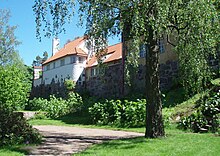Hvitträsk
Hvitträsk is a museum villa in Finland.
history
In 1886, Eliel Saarinen , Herman Gesellius and Armas Lindgren founded an architecture office in Helsinki as students. In 1898 they were commissioned to design the Finnish pavilion for the 1900 World Exhibition in Paris. That brought them recognition in Europe and new orders.
In 1901 the architects decided to move to the country. They bought 16 hectares of land by Lake Vitträsk in Kirkkonummi municipality . They wanted to be inspired by nature and the view of the lake. Every architect designed his own house. Construction work ended in 1903. All buildings are made of logs and granite .
The main building consists of two wings, the north wing, where Armas Lindgren lived, and the south wing, the home of Eliel Saarinen. Herman Gesellius lived in a small black villa on the other side of the courtyard.
The north wing of the main building was destroyed by fire in 1922. It was rebuilt in the thirties of the 20th century in the then modern style based on a design by Saarinen's son Eero . Today there are conference rooms here.
The black villa is used as a restaurant and café.
The south wing of the main building now serves as a museum. Saarinen's house is an architectural unit on all levels. The furniture is designed by the architect himself. They were made in the Boman cabinet maker in Tukru. The lamps are by the textile artist and sculptor Loja Saarinen, she was the wife of Eliel Saarinen and the sister of Herman Gessellius. The architect also designed the Rya carpets himself, except for one that was a gift from Akseli Gallén-Kallela . The copper works come from the art forge Eric Ehrström . The tiles of the tiled stoves are hand-made from Wilhelm Andstén's factory in Helsinki.
Armas Lindgren was also the director of the Arts Industry College and teacher at the Helsinki University of Technology. So he decided to move back to Helsinki. Herman Gesellius died in 1916. Saarinen then bought the entire property. The family lived permanently in Hvitträsk until 1923. After Saarinen won second prize in the Chicago Tribune Tower competition, he emigrated to the United States with his family.
In 1949 Saarinen sold the property to the couple Anelma and Rainer Vuorio. Twenty years later, the Salomon Wuorio Foundation took over Hvitträsk and opened the museum in 1971. Hvitträsk has been owned by the Finnish state since 1981.
Eliel Saarinen, his wife Loja and Herman Gesellius are buried in the forest of Hvitträsk.
Individual proof
Hvitträsk, leaflet of the Hvitträsk Museum, without author, without publisher, without date
Web links
- Biography of Eliel Saarinen ( English , Finnish )
- Hvitträsk
- Herman Gesellius
- Armas Lindgren
- Nikolai Boman
- Wilhelm Andstén
- Loja_Saarinen
- Anelma Vuorio
- Solomon_Wuorio
Coordinates: 60 ° 10 ′ 53 ″ N , 24 ° 31 ′ 12 ″ E


